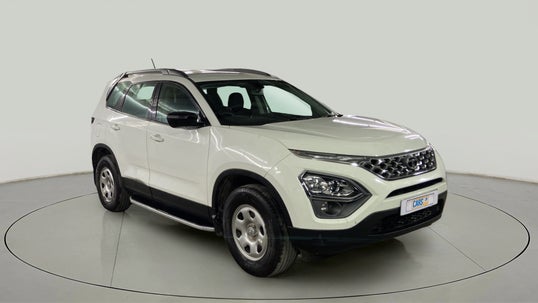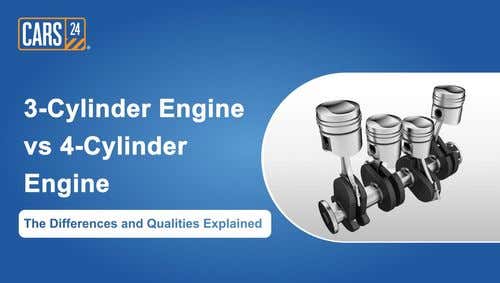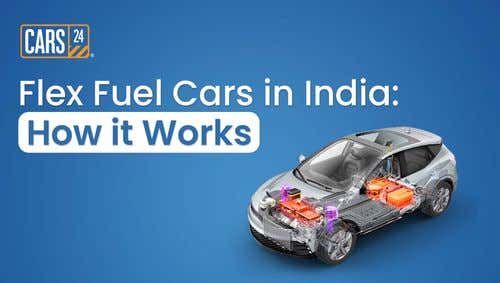What is a Wheel Alignment & why is it Important? Know The Procedure of Wheel Alignment

Updated on: 19th February, 2024 IST

Your car is more than a machine. It is your companion on the road of life. And, to keep your car in pristine shape, understanding the nuances of wheel alignment, sometimes referred to as tyre alignment or car alignment, is important.
At times, you may wonder about the wheel alignment cost, but let's assure you, it's a small investment for big benefits. In this blog, we will explain the wheel alignment procedure, explain why it's essential and how often you should consider it.
So, buckle up and join us as we pave the way for a smoother, safer, and more efficient ride.
Table of Contents
- What is Wheel Alignment?
- What Are The Symptoms Of an Out Of Alignment Car?
- What Is the Procedure Of Wheel Alignment?
- Wheel Alignment Adjustments
- Final Measurements
- What is the Cost of Wheel Alignment?
- How Often Should Wheel Alignments Be Done?
- Benefits of Wheel Alignment
- Difference Between Wheel Alignment and Tyre Balancing
- The Bottom Line
- FAQ
What is Wheel Alignment?
Wheel alignment, also known as car alignment or tyre alignment, is an important component of maintaining your vehicle. At its core, it's the method of fine-tuning the angles of your car's wheels. The objective is to ensure that these wheels stand perfectly upright in relation to the ground and parallel to each other.
The significance of this precision lies in facilitating optimal tyre contact with the road surface. When your wheels are aligned correctly, it promotes uniform tyre wear, translating to an extended tyre lifespan. Furthermore, it plays a crucial role in stabilising your car's handling, ensuring it moves smoothly and predictably.
What Are The Symptoms Of an Out Of Alignment Car?
Is your car trying to tell you something? If you know how to listen to your car, you will know that it communicates through subtle signs when it's misaligned. Paying attention to these symptoms can help you address alignment issues promptly, ensuring a smoother and safer ride.
Here are the common indicators of an out-of-alignment car:
1. Uneven Tyre Wear
- If you notice that some tyres are wearing down significantly faster than others, it's a strong indication that your wheels are not properly aligned
- This happens because misaligned wheels can cause uneven pressure on the tyres, leading to irregular wear patterns
2. Steering Wheel Vibrations
- If your steering wheel vibrates, especially at certain speeds or while turning, it's often a sign of alignment problems
- Misaligned wheels can create imbalances that transmit vibrations through the steering system
3. Pulling to One Side
- Due to misaligned wheels, your car starts to pull to one side, even when you're driving on a straight road
- This pulling sensation can cause your vehicle to veer off course
4. Drifting or Wandering
- When your car feels like it's wandering or drifting without your input, it's another symptom of alignment issues
- Properly aligned wheels should keep your car moving straight when the steering wheel is centred
5. Uneasy Handling
- A sensation of your car being less stable or harder to control can also indicate alignment problems
- You might find it challenging to keep your vehicle on the intended path, particularly during turns or on highways
In short, an out-of-alignment car communicates its discomfort through these noticeable signs. Ignoring these symptoms can lead to uneven tyre wear, decreased fuel efficiency, and compromised safety. If you notice any of these indicators, it's advisable to have your alignment checked promptly to ensure your vehicle continues to perform at its best.
Also Read: Car Suspension Guide
What Is the Procedure Of Wheel Alignment?
Wheel alignment is a meticulous process that ensures your car drives straight, handles well and maximises tyre lifespan. It's a fundamental aspect of vehicle maintenance that contributes to safety and performance on the road.
Here's a closer look at the step-by-step process of wheel alignment:
1. Initial Inspection
The process begins with a thorough inspection of your vehicle, including the tyres, suspension components, and steering system. This inspection helps identify any existing issues that may affect the alignment procedure.
2. Mounting Sensors
Specialised equipment is used to mount sensors to your vehicle's wheels. These sensors are crucial for collecting data throughout the alignment process.
3. Alignment Rack Setup
Your vehicle is driven onto an alignment rack or platform. This platform provides a stable surface for the alignment procedure and ensures your car is level.
4. Measurement of Current Alignment
Before any adjustments are made, the technician measures the current alignment settings of your vehicle's wheels. This includes assessing the camber, caster, and toe angles.
Wheel Alignment Adjustments
Based on the measurements and the manufacturer's specifications, the technician makes precise adjustments to the angles of your vehicle's wheels. Here's what each adjustment involves:
1. Camber Adjustment
- Camber refers to the vertical tilt of the wheel
- If the camber is off, it can lead to uneven tyre wear
- The technician adjusts the camber to ensure it aligns with the manufacturer's recommendations
2. Caster Adjustment
- Caster refers to the forward or backward tilt of the wheel
- Proper caster alignment ensures stability and steering control
- Adjustments are made as necessary
3. Toe Adjustment
- Toe angle refers to the direction the wheels point, whether they are parallel or slightly turned inward or outward
- Correct toe alignment is vital for steering accuracy
- Technicians adjust the toe angle to meet specifications
Also Read: How to Increase Life of Car Tyres?
Final Measurements
After the adjustments, the technician performs a final set of measurements to confirm that the wheels are now aligned correctly.
1. Test Drive
To ensure that the alignment adjustments have resulted in improved handling and stability, a test drive may be conducted.
2. Alignment Report
You'll receive an alignment report detailing the initial and final measurements, confirming that your vehicle now adheres to the manufacturer's alignment specifications.
What is the Cost of Wheel Alignment?
When your wheels lack proper alignment, it can result in uneven tyre wear, leading to the need for premature tyre replacements. Proper alignment offers several advantages, including enhanced fuel efficiency, better control, and a reduced risk of accidents.
Now, let's discuss the cost of wheel alignment in India. The price can fluctuate based on factors such as your vehicle type, location, and the service provider you choose. Typically, a standard wheel alignment in India falls within the range of ₹300 to ₹500.
When seeking a wheel alignment service, it's wise to shop around and compare prices. Opt for a reputable service provider equipped with state-of-the-art alignment equipment.
Ensure the alignment is performed on a level surface to achieve accurate results. Additionally, consider revisiting the alignment a few weeks later to confirm that it has held.
How Often Should Wheel Alignments Be Done?
Determining how often you should have your wheel alignment checked is crucial for maintaining your vehicle's performance and safety.
Here's how often you should get your wheel alignment checked:
1. Annual Check
- As a general rule of thumb, it's advisable to schedule a wheel alignment check at least once a year
- This routine check helps detect any gradual misalignment that might occur due to regular driving
2. Symptom-Based
- Keep an eye out for the symptoms mentioned earlier, such as uneven tyre wear, steering vibrations, or pulling to one side
- If you notice any of these signs, don't wait for your yearly check; have your alignment inspected promptly to address potential issues
3. After Impact
- If your vehicle encounters a significant impact, such as hitting a large pothole or curb, it's wise to have your alignment checked immediately
- Such incidents can easily knock your wheels out of alignment and affect your driving experience
4. Tyre Replacement
- Whenever you replace your tyres, consider it an opportune time to have your wheel alignment inspected and adjusted if necessary
- New tyres on a misaligned vehicle can wear unevenly and diminish their lifespan
Benefits of Wheel Alignment
Unlocking the benefits of wheel alignment can significantly enhance your driving experience and vehicle longevity. Here's a breakdown:
1. Extended Tyre Lifespan
- Proper wheel alignment ensures that your tyres wear evenly
- This not only maximises the lifespan of your tyres but also saves you money by avoiding premature replacements
2. Improved Fuel Efficiency
- Correctly aligned wheels reduce rolling resistance
- This means your vehicle encounters less resistance from the road, which translates into improved fuel efficiency
- You'll get more kilometres per litre, saving both money and resources
3. Enhanced Handling and Stability
- A well-aligned vehicle handles more predictably, especially during turns and manoeuvres
4. Safer Driving
- Wheel alignment contributes to overall road safety and minimises the risk of your vehicle pulling to one side unexpectedly
- This reduces the chances of accidents, particularly during sudden manoeuvres or adverse road conditions
5. Smooth Ride
- Properly aligned wheels provide a smoother and more comfortable ride
- You'll notice fewer vibrations and less steering effort, making your journeys more enjoyable
Also Read: When Should You Change the Tyres of Your Car?
Difference Between Wheel Alignment and Tyre Balancing
Wheel alignment and tyre balancing are distinct yet complementary procedures. Wheel alignment primarily centres on the angles and positioning of your car's wheels in relation to the vehicle itself and the road. Think of it as the "directional compass" of your vehicle.
Proper alignment ensures that your car travels straight when the steering wheel is centred. It enhances stability, handling, and tyre wear by ensuring all four wheels work harmoniously.
Tyre balancing, on the other hand, addresses the distribution of weight around each tyre and wheel assembly. It aims to eliminate any uneven weight distribution that could lead to vibrations or wobbling while driving. Tyre balancing ensures a smooth and vibration-free ride.
Also Read: Preventing Tyre Burst: Understanding Its Dangers
The Bottom Line
Understanding the fundamentals of wheel alignment and tyre balancing is your roadmap to a smoother, safer, and cost-effective journey on the road. Remember that wheel alignment focuses on the correct direction of your wheels, keeping you on the right path, while tyre balancing ensures your ride remains vibration-free and comfortable.
By investing in regular wheel alignments, you extend your tyre lifespan, improve fuel efficiency, and enhance handling, all while prioritising safety. Additionally, tyre balancing adds that extra touch of comfort to your drive.
So, don't overlook these essential steps in vehicle maintenance. Take the initiative to keep your car in optimal condition, and you'll enjoy a smoother and more enjoyable ride every time you hit the road.
FAQ
Q. How much does an alignment cost?
The cost of a wheel alignment in India typically ranges from ₹300 to ₹500, depending on factors like location, vehicle type, and the service provider.
Q. How do you know if your wheels need alignment?
You may need a wheel alignment if you notice symptoms like uneven tyre wear, steering wheel vibrations, or your car pulling to one side when driving on a straight road.
Q. What is the main reason for wheel alignment?
The primary reason for wheel alignment is to ensure that your vehicle's wheels are correctly positioned to promote even tyre wear, enhance handling, and improve fuel efficiency.
Q. Is 4-wheel alignment necessary?
While front-wheel alignment is common, a 4-wheel alignment is advisable, as it ensures that all wheels are properly aligned, enhancing stability and tyre wear.
Q. How long does wheel alignment last?
The duration of a wheel alignment's effectiveness can vary, but it's generally recommended to check it at least once a year or after significant impacts or tyre replacements.
Q. Is alignment needed with new tyres?
It's a good practice to align your wheels when fitting new tyres to maximise their lifespan and ensure optimal performance.
Q. How many kilometres before you get a wheel alignment?
There's no specific kilometre requirement for wheel alignment, but it's wise to check alignment annually or when experiencing alignment-related symptoms.
Q. Is wheel alignment a serious problem?
Wheel alignment issues may not be immediately serious, but neglecting them can lead to uneven tyre wear, reduced fuel efficiency, and compromised handling, potentially affecting safety
Recently Added Cars to Buy
Other Blogs
- Recent
- Featured
Popular Cities to Sell Car
























